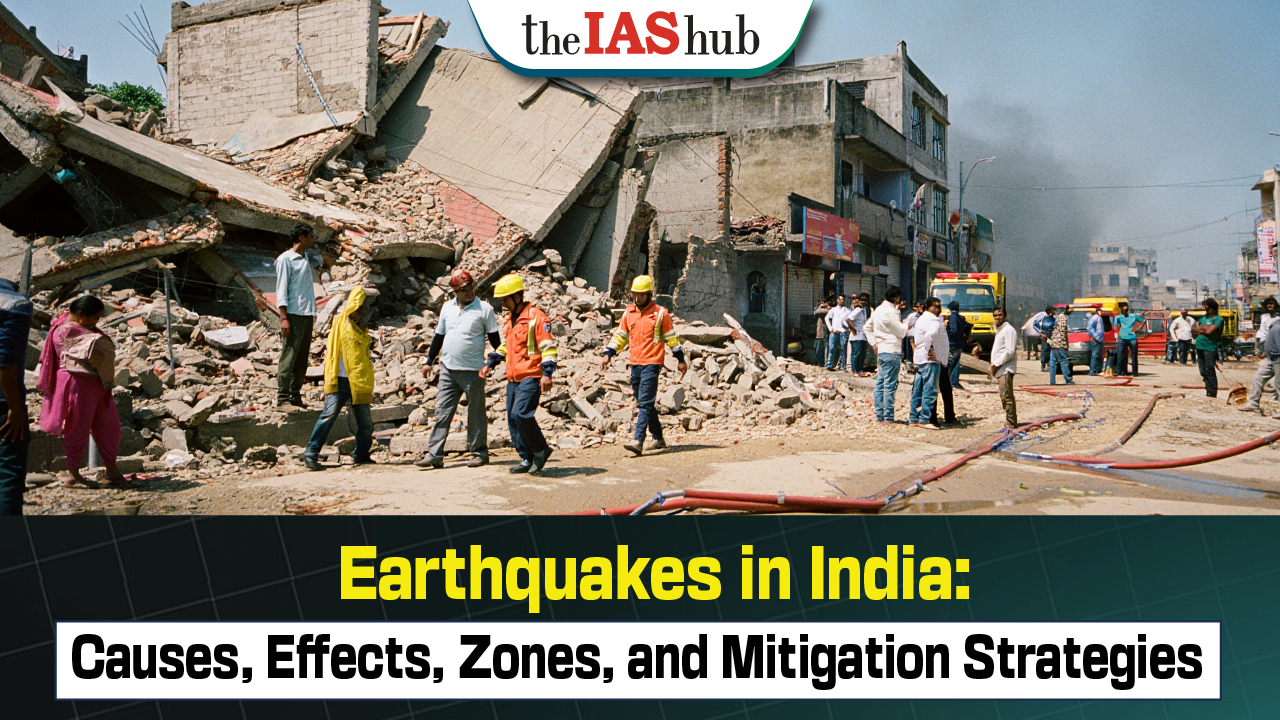Explore earthquake causes, impact, seismic zones, and disaster management strategies in India. Learn about NDMA guidelines, focus and epicentre, and how to build earthquake-resistant infrastructure for safer communities.


An earthquake is a violent and abrupt shaking of the ground, caused by movement between tectonic plates along a fault line in the earth's crust. Earthquakes can result in ground shaking, soil liquefaction, landslides, fissures, avalanches, fires, and tsunamis.
|
|
Impact of Earthquakes |
Description |
|
Shaking and Ground Rupture |
Damage to rigid structures, major risk to large engineering structures. |
|
Landslides and Avalanches |
Can result from earthquakes, causing slope instability. |
|
Fires |
Caused by damage to electrical power or gas lines; can result in more fatalities than the quake itself. |
|
Soil Liquefaction |
Transforms water-saturated soil from solid to liquid, causing structures to tilt or sink. |
|
Tsunami |
Megathrust quakes can move large water volumes, producing long-wavelength, long-period sea waves. |
|
Floods |
Secondary effects of earthquakes due to dam damage or landslips that dam rivers. |

Credit: Maps of India
Important institution to prevent and mitigate earthquake loss
|
Earthquake vulnerabilities can be reduced due to integrated approaches at international, national, and local levels. Education to people about earthquake safety and preparedness, including how to evacuate safely and what to do during an earthquake is essential. With this Implement early warning systems that can alert people of an impending earthquake, giving them time to evacuate or take other safety measures. And at last Develop emergency response plans that outline the actions to be taken in case of an earthquake, including evacuation procedures and contingency plans for power restoration and other critical infrastructure.


Refine your answer writing skills and elevate your UPSC preparation with personalized support and expert feedback.
Fill out the form to get started with the program or any other enquiries !








Are you dreaming of becoming an IAS officer? Then, IAShub can be your best guide. It is one of the Best IAS Coaching in Delhi. Many students who want to clear the UPSC exam join IAShub for learning. The institute gives both online and offline classes. Their teachers are experienced and helpful. They easily explain every topic. Students also get notes, tests, and tips to do well in the exam.
IAShub is in Delhi and is trusted by many UPSC students. It offers coaching for every part of the UPSC exam – Prelims, Mains, and Interview. The classes are simple and easy to understand. The teachers are experts and guide students in the right way. IAShub is also known for its helpful notes, test series, and answer-writing practice. IAShub is the best coaching in Delhi and also gives UPSC Online Classes. This helps students from any place in India to learn. The online classes are live and also recorded. So, students can watch them anytime. These classes cover the full UPSC syllabus.
Here are some important services provided by IAShub:
The UPSC Civil Services Exam has three parts:
This exam is tough, but with the right guidance, it becomes easy to manage. Students must study smart and stay regular.
IAShub supports students from the beginning to the end. It gives the right books, tests, and notes. The classes are easy to follow, and the teachers are always ready to help. Students get personal doubt sessions too. The test series and answer checking help students learn where they need to do better. Also, free study materials save time and money.
IAShub also guides students during the final stage – the interview. Experts take mock interviews and give useful tips. This full support makes IAShub one of the best IAS coaching in Delhi.